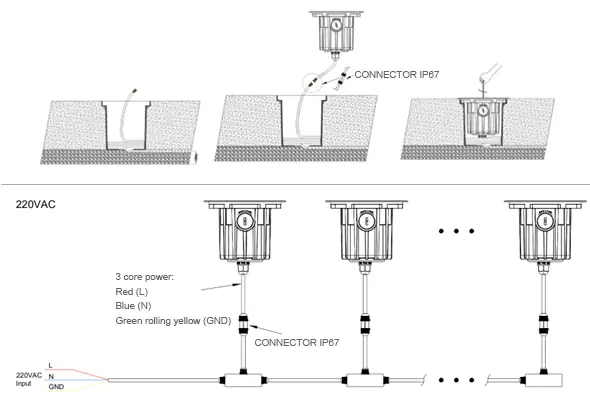LED underground or ground lights are very popular because they can illuminate a space without disrupting the landscape. They are most commonly found in paths and gardens, but are also useful for lighting elsewhere.
;
What is underground lighting?
;
Underground light is a type of lighting that is installed underground to illuminate sidewalks, parking lots, and other walkways. It can also be used to illuminate gardens and landscaping. Installing underground lighting is a perfect solution for illuminating hard to reach spaces.
;
What are the benefits of underground light
;
- You can have a lower electric bill when you opt for underground light because these are much more efficient.
- Not only do LEDs last a lot longer than other types of lights, they require less upkeep in the process. The only thing that this might impact negatively is the aesthetic aspect; however, the light not requiring upkeep can end up saving you a lot of time and money in the long run.
- When you’;re browsing underground light, you’;ll notice you have a choice of effects, brightness levels, and angles to direct them. This means you have complete control and an extraordinary range of customization.
- LED well lights are incredibly versatile thanks to their wide range of brightness levels and other effects. No matter what situation you’;re in, you’;ll likely find something that works.You and your guests can stay safe by installing underground light. To do so, they illuminate any obstacles along the path and reduce the risk of tripping and falling.
- The bulb of underground light fixtures is sunk into the ground rather than being elevated above ground level, so it won’;t overshadow your surroundings like a larger pole light or bright bulb might. These light fixtures are ideal for getting light without obscuring what’;s in the landscape.
- underground light can also reduce trip risks because they do not protrude from the ground. However, the surface level may still vary slightly with the light, but it will be much less than with other forms of lights.As the lights don’;t go above the ground, they are less likely to be damaged by foot traffic, stray balls, or other objects.
;
Where is the underground light used?
;

Since underground lights are mounted at the top of the ground, you will need to keep in mind where you plan to use the light. Underground lights are most commonly used for sidewalks and other areas that require light but don’;t have a lot of room for an above-ground fixture.
You can also use them as accent lighting or as a safety light at entrances. When deciding what kind of underground light is best for your home, you should consider where the power is available and if there is an existing light source nearby. If not, installing an underground lamp might be difficult. In general, they do not work well in tight spaces or dark corners because they have a wide area of illumination rather than spotlights like their above-ground counterparts.
;
How to choose an underground light
Think about what you want to focus on in the image.
It is important to decide what your goals are before installing LED underground light, since your choice will be influenced by these goals. For example, if you want to light up a small plant, a low-wattage light will likely suffice. The brighter the light, the better if you want to illuminate a path or something far off the ground.
Consider what type of lighting you want.
You will have to choose among the various types of underground light outlined above. Your choice will largely depend on how much light you want to come through and in which direction you want it to point.
Consider brightness as well.
Pay attention to the wattage of lights when choosing them. Their brightness will be determined mainly by their wattage. The more watts, the brighter the light. The fewer watts, the dimmer the light.
Make sure it’;s rated for outdoor use.
Be sure the well lights you buy are rated for outdoor use. This is not the case with all lights, so read the product description first. Since outdoor lights will be exposed to rain, wind, dirt, and other elements, they should have an outdoor use rating.
;
Installing underground lights

1.If possible, try to install the climbing tower on loose or soft ground.
The process of installing an underground LED will be simpler when done in softer ground; it will be much easier to move around and level the dirt.
2.Dig a hole or a trench.
Put your light fixture in the ground, about 3 to 4 inches wider and 12 inches deeper than the fixture itself.
The only thing left to do is fill the hole with some light gravel.
3.Make sure the wiring is in order.
After installing the light fixture, you’;ll want to connect it to the sewer. Always make sure to leave enough slack in the wire so you can bury it if necessary. Taking these preventative measures before finishing the installation means that, if you later choose to change the location of the light, the wiring will not have to be done all over again.
4.Fill in the remaining dirt and level it.
Finally, fill in the rest of the hole with soil, keeping the fixture level and clear.
5.Differences when using concrete &; mortar
For concrete underground lights, you will need to place a hollow piece in the hole you dig, then pour in concrete. It is also a good idea to run the conduit through this piece to ensure the wire is suitable for the light. When the concrete is dry, slip the light into the hollow piece.
;
結論
Underground LED lights don’;t interrupt the natural surroundings and aren’;t as likely to cause injuries like tripping or running. You might see them along pathways and lighting up the whole of a landscape. There are many outdoor lighting options available, such as lanterns from Lacelesty Lighting. Get in touch with us today to learn more.







